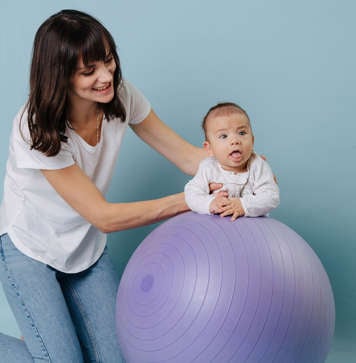Tummy time helps to strengthen your child’s neck, stomach, back and arm muscles which can be important for the development of later, more advanced movement skills. These include sitting, crawling, standing, and hand and finger skills. It is important for your child to practice tummy time activities when they are awake and supervised. Try doing these activities throughout each day when your child is happy and ready to play. Practice these activities regularly starting out with brief periods and gradually increasing the length of time as your child gets used to tummy time.

Beginning tummy time
Encourage your child to lay on their tummy when awake and supervised. Alternate which direction your child’s head is rotated so that they get strong on both sides and to prevent head flattening. Your child may like to suck on their hand for comfort or to have their bottom patted gently in this position.

Carrying child on your chest
Place your child on your chest. Support your child’s hips and back. This is a good position to introduce tummy time. As your child gets stronger, they will lift their head up to look around. Encourage them to lift their head up to look up at your face or at their surroundings. As your child gets stronger, then you can try holding them over your shoulder.

Lying on your chest
Lie down and place your child on their tummy on your chest. Ensure their arms are forward so they can push up and lift their head to look up.

Tummy time on your lap
Place your child on their tummy over your lap. Support their back and hips. Encourage them to lift their head to look up at a toy. Some babies enjoy gentle bouncing or having you pat their bottoms in this position.

Tummy down carry
Place your child over your arm on their tummy and hold them close to your chest. As your child gets stronger, they will learn to lift their head up. Try rocking them gently back and forth. Doing this activity in front of a mirror may encourage your child to lift their head.

Tummy time with roll under chest and arms
Place a rolled blanket or cushion under your child’s chest and arms to help make it easier for them to lift their head. Ensure their arms are forward with elbows under shoulders. Encourage them to take their weight through their arms and hands and lift their head up. Provide some pressure to their bottom to provide extra stability and to help bring their weight backward. This makes it easier for your child to lift their head up.

Elevated tummy time
Some children enjoy tummy time more if they are elevated compared to being flat on their tummies. Try introducing tummy time over a breastfeeding pillow, over your thigh or even supported over a couch cushion.

Tummy time on ball
Place an exercise ball against a wall or couch so it doesn’t move too much. Next, place your child on their tummy on the exercise ball. Support your child and give some downward pressure on their bottom to help them lift their head more easily. Slowly rock your child on the ball forward, backward and side to side. You can also try gently bouncing the ball up and down. Singing songs on the ball or going in front of a mirror can be fun activities for your child.

Flat tummy time
As your child gets stronger place them flat on their tummy on a blanket on the floor/mat. Lay down in front of them to encourage them to lift their head and push up on their arms to look at you. Try shaking a colourful or musical toy in front of them to encourage them to lift their head up to look at it.

Reaching for toys
Place your child on their tummy, taking weight on their arms. Encourage your child to shift their weight when on their tummy to reach for a toy with one hand. At first, you may need to guide your child’s arm and hand to reach.

Pushing up on extended arms
Place your child on their tummy taking weight on their arms. You may need to help them keep their arms straight by supporting their shoulders. To make this activity easier, you can try placing your child over your leg while you are seated on the floor. Encourage your child to push up on their arms with elbows straight, putting weight through open hands.

Rocking on extended arms
Once your child can easily keep their head upright and put weight through their arms, you can try gently rocking their arms forward/backward and from side to side. This will help strengthen your child’s shoulder and arm muscles in preparation for crawling.
Baby push-ups
Place your child on their tummy and guide them to push up on extended arms. Hold your child’s hips and lift their thighs off the floor. Try gently rocking your child forward and backward. To make this activity more challenging, move your hands down and hold your child’s lower thighs.

Pivoting
Place your child on their tummy. Place a toy on one side and encourage them to reach for it. Try tickling your child on the side you want them to reach for. Keep moving the toy to encourage your child to learn to pivot around in a complete circle.
Additional activities recommended by your child’s therapist